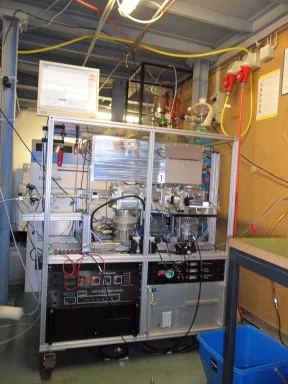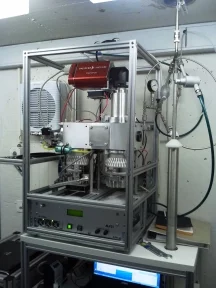The Aerodyne aerosol mass spectrometer (AMS) provides quantitative, size-resolved mass spectra of non-refractory aerosol between approximately 60 and 600 nm. The AMS detection scheme combines thermal vaporization with subsequent electron impact ionization and detection by mass spectrometry. Measured species include organic aerosol (OA), as well as some inorganic salts such as ammonium nitrate and ammonium sulfate. Several AMS types and modifications are in use at PSI, and are described below.
AMS measurements are part of a variety of projects at PSI. It is used to quantify and characterize the secondary organic aerosol produced in stationary and mobile smog chamber experiments. The AMS is a critical tool for source apportionment of ambient organic aerosol, and is regularly deployed on both mobile and stationary platforms. Stationary measurements include both intensive campaigns and long-term measurements. AMS mass spectra are used with the positive matrix factorization and multilinear engine receptor models to identify primary OA sources and secondary OA types.
High-Resolution Aerosol Mass Spectrometer (HR-ToF-AMS)
AMS measurements are part of a variety of projects at PSI. It is used to quantify and characterize the secondary organic aerosol produced in stationary and mobile smog chamber experiments. The AMS is a critical tool for source apportionment of ambient organic aerosol, and is regularly deployed on both mobile and stationary platforms. Stationary measurements include both intensive campaigns and long-term measurements. AMS mass spectra are used with the positive matrix factorization and multilinear engine receptor models to identify primary OA sources and secondary OA types.
High-Resolution Aerosol Mass Spectrometer (HR-ToF-AMS)
The high-resolution time-of-flight aerosol mass spectrometer (HR-ToF-AMS) continuously samples particles through a critical orifice into an aerodynamic lens. The lens focuses the particles into a narrow beam and accelerates them to a velocity inversely related to their vacuum aerodynamic diameter. The particles impact a resistively heated tungsten surface (600 C, 10-7 torr), where they flash vaporize. The resulting gas is ionized by electron impact and the ions are detected by a time-of-flight mass spectrometer. The AMS normally operates between two operating modes. In the first mode, the particle beam is alternately blocked and unblocked, yielding the ensemble mass spectrum. In the second mode, modulation of the particle beam by a spinning chopper wheel generates pulses of particles. Because the particle velocity is size-dependent, this mode yields size-resolved mass spectra. High-resolution mass spectra can be used to identify specific ions, enhance source apportionment, and describe organic composition in terms of molecular O:C and H:C ratios.
Aerosol Chemical Speciation Monitor (ACSM)
The ACSM is a smaller version of the AMS, designed for low-maintenance, robust operation at the cost of reduced sensitivity and mass resolution. These features make it ideal for long-term monitoring. The ACSM utilizes a quadrupole mass spectrometer, an internal naphthalene standard, and removes sizing capabilities. The particle flow is periodically pulled through an external filter, enabling subtraction of the ambient air mass spectrum. PSI has deployed an ACSM in downtown Zürich since January 2011.
PM2.5 Aerodynamic Lens
A recently developed aerodynamic lens extends the AMS transmission into the super-micron size range. This both improves the AMS PM1 measurement capability and enables detection of new particle types, such as primary biological aerosol. Initial field tests were conducted in downtown Zürich during Spring 2011.
Light Scattering/Single Particle Analysis
An optical scattering module integrated with the HR-ToF-AMS provides a signal for all particles larger than the detection limit of ~200 nm. Signal from a detected particle is used to trigger saving of the corresponding single particle mass spectrum. This data enables interrogation of the aerosol mixing state, identification of unique particle types, and measurement of the AMS collection efficiency.
The ACSM is a smaller version of the AMS, designed for low-maintenance, robust operation at the cost of reduced sensitivity and mass resolution. These features make it ideal for long-term monitoring. The ACSM utilizes a quadrupole mass spectrometer, an internal naphthalene standard, and removes sizing capabilities. The particle flow is periodically pulled through an external filter, enabling subtraction of the ambient air mass spectrum. PSI has deployed an ACSM in downtown Zürich since January 2011.
PM2.5 Aerodynamic Lens
A recently developed aerodynamic lens extends the AMS transmission into the super-micron size range. This both improves the AMS PM1 measurement capability and enables detection of new particle types, such as primary biological aerosol. Initial field tests were conducted in downtown Zürich during Spring 2011.
Light Scattering/Single Particle Analysis
An optical scattering module integrated with the HR-ToF-AMS provides a signal for all particles larger than the detection limit of ~200 nm. Signal from a detected particle is used to trigger saving of the corresponding single particle mass spectrum. This data enables interrogation of the aerosol mixing state, identification of unique particle types, and measurement of the AMS collection efficiency.



